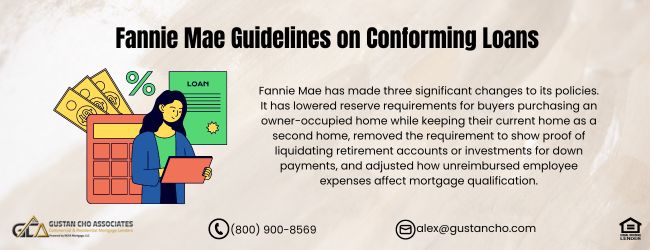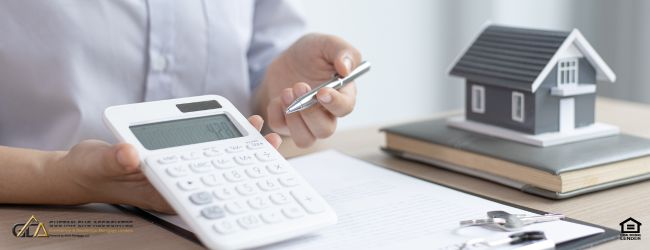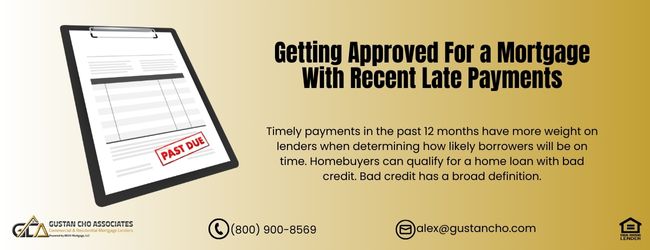Fannie Mae Guidelines on Conforming Loans

This guide covers updated Fannie Mae guidelines on conforming loans. Fannie Mae has made some recent changes to their guidelines. Three changes will open up lending in the Fannie Mae Conforming Market. They account for a high market share of loans originating in the last ten years. The first change is when a buyer purchases an owner-occupied home while keeping their current home as a second home.
The updated Fannie Mae Guidelines required they show six months of reserves. Reserve requirements are both on the mortgage, and second on the home they still have.
This made qualifying for homes difficult as some fell short of the amount verified. This was implemented during the financial crisis, as many homeowners could not sell their current homes due to a lack of demand. Or they had a tough time renting it out to cover the mortgage and taxes. Some even chose to let the old home go into foreclosure as they were buying a new one at a discounted price, in some cases in the other spouse’s name, who was not on the current loan.
Second Updated Fannie Mae Guidelines on Conforming Loans
The second change with the new updated Fannie Mae Guidelines is the removal of proof a borrower is liquidating any retirement account or investments to secure a down payment. The process is and has always been challenging and time-consuming. They now need to show proof they have the funds.
Fannie Mae is committed to supporting affordable housing and sustainable homeownership for all Americans. Whether you are looking for a mortgage to buy, refinance, or rent a home, Fannie Mae has a product or option that can suit your needs and budget.
The other calculation reverses the old rule, which would only use 70% of the fund’s value. Should the mortgage loan borrower now have 20% or more funds necessary for the down payment, they will not have to show proof of liquidation. They will receive 100% credit for the full value of the account, hence giving them more assets than before, per the underwriter’s viewpoint. Connect with our expert for Fannie Mae guideline on conforming loans
Changes on Updated Fannie Mae Guidelines on Conforming Loans
The last change is currently unreimbursed employee expenses or 2106 expenses. This pertains to the borrower having unreimbursed expenses as a W2, such as gas, food, etc. These items would traditionally reduce the borrower’s net income, making it harder to qualify for a mortgage. New rule: if the client receives a bonus or overtime, so long as their salary is 75% of total income, and bonuses are 25% or less, this will not be counted against them. Fannie Mae is losing market share to FHA. They also see the current market as safer and will slowly increase risk tolerance. The changes will be slow. But expect more so long as the job market stabilizes and grows and incomes rise above inflation rates.
Role of Fannie Mae
This section will cover the updated Fannie Mae Guidelines that can help many homebuyers achieve their homeownership goals. Fannie Mae, a government-sponsored enterprise, is one of two mortgage giants in the nation that buys mortgage loans on the secondary market. It is due to Fannie Mae that mortgage lenders can offer mortgage loans because Fannie provides liquidity in the mortgage markets. Fannie Mae does not lend money directly to borrowers. Fannie Mae buys mortgages from lenders as long as the loans conform to Fannie Mae Guidelines, making it easier and cheaper for lenders to offer mortgages to more people. Fannie Mae’s mission is to provide liquidity, affordability, and stability to the U.S. housing market.
Updated Fannie Mae Conforming Loan Programs
Fannie Mae HomeReady®: Available for first-time and repeat homebuyers, the HomeReady ® program allows you to buy a home, refinance to lower your rate, or change your loan term with as little as a 3% down payment or in existing equity. It supports homeownership and rental housing for low- and moderate-income Americans, underserved communities, and rural areas. It also promotes innovation and technology in the mortgage industry and helps borrowers facing financial hardship or disaster recovery. The program also offers flexible income sources, such as rental income from a border or an accessory dwelling unit (ADU), and reduced mortgage insurance costs. You can also take advantage of online homeownership education courses to prepare for the home-buying process and homeownership responsibilities. Talk to our loan officers for your mortgage enquiry
How Does Fannie Mae’s HomeReady Mortgage Program Work?
The HomeReady ® program is designed to help you overcome common homeownership barriers, such as saving for a down payment, having a low credit score, or having a limited income. For example, if you buy a home with a 3% down payment, you can use funds from your savings, gifts from family or friends, grants from nonprofit organizations, or employer assistance programs. You can also use income from other household members or renters to qualify for the mortgage, even if they are not on the loan. The HomeReady ® program also helps you save money on your monthly payments by offering lower interest rates and mortgage insurance premiums than conventional loans. You can also cancel your mortgage insurance once your loan balance reaches 80% of the value of your home, which can happen faster with a shorter loan term or higher home appreciation.
Updated Fannie Mae Guidelines on HomeReady Mortgage
To be eligible for the HomeReady ® program, you must have a credit score of at least 620, a DTI ratio of no more than 50%, and complete an online homebuyer education course. You must also meet certain income limits based on the area median income or AMI of the property location. You can check your eligibility and find participating lenders on the Fannie Maes website.
Fannie Mae Guidelines on HomePath Program
A program that offers special financing and incentives for buyers of Fannie Mae-owned properties. These properties are usually foreclosed homes that Fannie Mae has acquired and renovated. You can find various homes in different locations and price ranges, from single-family homes to condos. Some benefits of buying a HomePath property are low down payment options, no appraisal fees, no mortgage insurance, and flexible financing terms. You can get up to 3% closing cost assistance if you complete an online homebuyer education course.
How HomePath Program Work?
The HomePath program is ideal for buyers looking for a bargain or an investment opportunity. You can buy a HomePath property with as little as 3% down using conventional financing or other FHA or VA loans. You can also use renovation financing to customize the property to your liking or increase its value. The HomePath program also simplifies the buying process by eliminating some fees and requirements that typically apply to foreclosed properties. For example, you do not need an appraisal to determine the property's value, saving you time and money. You also do not need to pay for private mortgage insurance (PMI), which can lower your monthly payments.
Fannie Mae HomePath Eligibility Requirements
To be eligible for the HomePath program, you must have a credit score of at least 620, a DTI ratio of no more than 45%, and complete an online homebuyer education course if you use closing cost assistance. You must also intend to use the property as your primary residence or investment property. You can browse available properties and find participating lenders on the Fannie Maes website.
Updated Fannie Mae Guidelines on RefiNow™
This expanded eligibility refinance option opens up new possibilities for you and your borrowers. To qualify, homeowners need to have a Fannie Mae-backed mortgage, earn up to 100% of their area median income (AMI), be up to date on their payments, and have a loan-to-value ratio of 97% or lower. The RefiNow™ option can help you lower your interest rate by at least 0.5%, reduce your monthly payment by at least $50, and save on closing costs.
How Does Fannie Mae RefiNow Work?
The RefiNow™ option is designed to help you take advantage of the historically low-interest rates and save money on your mortgage. Refinancing your existing loan can lower your interest rate and monthly payment, improving your cash flow and financial stability. Homeowners can shorten their mortgage loan term by refinancing, which can help them pay off their mortgage sooner and build equity in their home. The RefiNow™ option also helps you save money on the refinancing process by offering a credit of up to $500 for an appraisal if one is required and waiving the adverse market refinance fee of 0.5% that applies to most refinance loans. You can also roll your closing costs into your new loan balance, which can reduce your upfront expenses.
Fannie Mae Guidelines on RefiNow Eligibility Requirements
To be eligible for the RefiNow™ option, you must have a Fannie Mae-backed mortgage that originated on or before October 1, 2020, and have a current interest rate above 3%. You must also have a credit score of at least 620, a DTI ratio of no more than 65%, and no missed payments in the past six months. You can check your eligibility and find participating lenders on the Fannie Maes website.
Updated Fannie Mae Guidelines on Tenant-In-Place Rental Program
A program allowing renters to stay in their homes after Fannie Mae acquires the property through foreclosure or foreclosure. If you rent a property owned by Fannie Mae, you may be eligible to sign a new lease with Fannie Mae or its property manager at a market rate rent. You can also get relocation assistance if you decide to move out.
How Does The Fannie Mae Tenant-In-Place Rental Program
The Tenant-In-Place Rental Program protects renters’ rights and prevents displacement after a foreclosure. You can continue living in your home without interruption or eviction if you pay your rent on time and comply with the lease terms. Renters benefit from the services and amenities of professional property management, such as maintenance services, online rent payment options, and tenant portals. The Tenant-In-Place Rental Program also allows you to move out if you prefer. You can terminate your lease without penalty by giving a 30-day notice. You can also receive up to $1,000 in relocation assistance if you move out within 90 days after Fannie Mae acquires the property.
Fannie Mae Tenant-In-Place Rental Eligibility Requirements
To be eligible for the Tenant-In-Place Rental Program, you must have a valid lease or rental agreement with the property’s prior owner. Or the tenant needs to be able to prove that they are a bona fide tenant with documentation such as utility bills or bank statements. ]
Renters must pay a market rate rent that is not substantially lower than the fair market rent for the area. Renters can check if your property is owned by Fannie Mae by using the Renters Resource Finder on the Fannie Mae website.
You can learn more about Fannie Mae’s mortgage products and options by visiting their website or contacting a participating lender. If you face financial challenges or foreclosure, you can get help from Fannie Maes Mortgage Help Network or Tenant-In-Place Rental Program. Fannie Mae is here to help you achieve your homeownership goals and make your dream home a reality.
Speak with our expert for your mortgage enquiry
FAQs: Fannie Mae Guidelines on Conforming Loans
- What are the recent changes to Fannie Mae’s guidelines on conforming loans? Fannie Mae has made three significant changes to its policies. It has lowered reserve requirements for buyers purchasing an owner-occupied home while keeping their current home as a second home, removed the requirement to show proof of liquidating retirement accounts or investments for down payments, and adjusted how unreimbursed employee expenses affect mortgage qualification.
- How have the reserve requirements for owner-occupied homes changed? The new guidelines require showing six months of reserves on the new mortgage and the existing home. This change makes it easier for buyers who want to keep their current home as a second home while purchasing a new one.
- What is the new policy regarding liquidating retirement accounts or investments? Borrowers no longer need to provide proof of liquidating retirement accounts or investments for down payments. Instead, they need to show they have the funds available. Borrowers can now receive 100% credit for the full value of their accounts if they have 20% or more of the funds necessary for the down payment.
- How do the changes to unreimbursed employee expenses affect mortgage qualification? Under the new guidelines, unreimbursed employee expenses no longer reduce the borrower’s net income if their salary constitutes at least 75% of their total income and bonuses are 25% or less.
- What is the Fannie Mae HomeReady® program? The HomeReady® program is designed for first-time and repeat homebuyers, offering options to buy a home, refinance, or change loan terms with as little as a 3% down payment. It supports low- to moderate-income Americans and provides flexible income sources and reduced mortgage insurance costs.
- What are the eligibility requirements for the HomeReady® program? To qualify, you need a credit score of at least 620, a DTI ratio of no more than 50%, and completion of an online homebuyer education course. It would help if you also satisfied specific income thresholds determined by the area median income (AMI) of the property location.
- What is the Fannie Mae HomePath® program? The HomePath® program offers special financing and incentives for buyers of Fannie Mae-owned properties, usually foreclosed homes. Benefits include low down payment options, no appraisal fees, no mortgage insurance, and flexible financing terms.
- How can I qualify for the HomePath® program? You need a credit score of at least 620, a DTI ratio of no more than 45%, and completion of an online homebuyer education course if closing cost assistance is used. The property should be meant for either your main residence or as an investment property.
- What is the RefiNow™ option? The RefiNow™ option allows homeowners with Fannie Mae-backed mortgages to refinance and lower their interest rates and monthly payments. Eligible homeowners earn up to 100% of the median income in their area and are up to date on their payments.
- What are the eligibility requirements for the RefiNow™ option? Homeowners must have a Fannie Mae-backed mortgage that originated on or before October 1, 2020, a credit score of at least 620, a DTI ratio of no more than 65%, and no missed payments in the past six months.
- What is the Tenant-In-Place Rental Program? This program allows renters to stay home after Fannie Mae acquires the property through foreclosure. Renters can sign a new lease at market rate rent or receive relocation assistance if they decide to move.
- How can I qualify for the Tenant-In-Place Rental Program? You must have a valid lease or rental agreement with the prior owner or prove you are a bona fide tenant. Renters must pay a market rate rent not substantially lower than the area’s fair market rent.







Responses